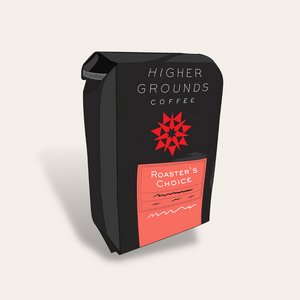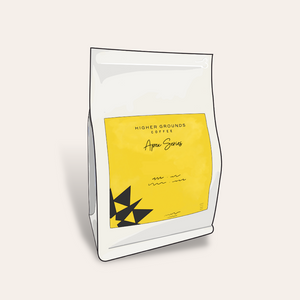It’s not easy being a coffee farmer. Plenty of challenges are at the forefront of nearly every task, from deciding which variety of plant to put in the ground, to accessing fertilizer, to the often-complicated logistics of getting the coffee to a buyer. As a coffee roasting business who is directly invested in our cooperatively-owned importer, Higher Grounds aims to support our farming partners every step of the way. So when the farmers of Manos Campesinas in Guatemala invited Cooperative Coffees’ roasters to come taste and evaluate the results of some experimental planting they did three years ago, I couldn’t resist the opportunity.
Coffee from Guatemala represents our third-highest-volume origin, finding its way into several products (Justice, Mayan Magic Espresso, Safe Passage, and Guatemalan San Marcos medium roast). The consistency and quality of this coffee makes it a versatile and popular offering. Three years ago, Manos Campesinas, the umbrella exporter for several producer cooperatives in Guatemala, was spurred to action by the large-scale devastation many farmers were experiencing as a result of La Roya (coffee leaf rust or fungus). Farmers were asking for solutions, and Manos wanted to help but didn’t yet have good answers. So they embarked upon an extensive research project to determine which coffee varieties would be most resistant to disease and perform the best at a range of elevations (since the elevation of their farms ranges from 1300-1800 meters above sea level), with different organic fertilization treatments. They wanted to measure quality, productivity, and resistance to both La Roya and Ojo de Gallo, another fungus. Both of these diseases can decimate entire coffee crops, drastically reducing yields and lowering quality. The technicos (technical advisers) on staff for Manos developed a methodology for conducting this experiment and for the data collection that has taken place over the last two years, recruiting and training farmers who could offer up space on their farms as test plots.
This experimental planting project was funded by Cooperative Coffees, Equal Exchange, and a few other independent roasters who purchase from Manos Campesinas. (Higher Grounds contributes to Cooperative Coffees’ Resilience Fund, which is used to support projects like this one.) We’ve been buying coffee from them for over a decade, but this was the first time I had the opportunity to visit them in person. After three years of careful attention to these plants and lots of data collection, the first harvest was ready to roast and taste.
First we learned about the basis for research and data collection process:
Varietals planted: Icatu, Costa Rica 95, Catuai, Bourbon, Anacafe 14
Size of test plots: 1/2 hectare (1.2 acres), broken into 10 x 700 m2 sections
Number of plants: 1000 per plot (100 plants per section)
After the first year, two different fertilization treatments were applied. T1 was provided by Manos Campesinas and was the same for all test plots regardless of elevation, soil quality, or varietals. T2 was based on a recipe provided to each farmer, from which he mixed the ingredients he could find locally.

Every two months, Juan Carlos Mansilla, a technico for Manos (pictured above), logged data from 42 plants out of every 100-plant section, noting which plants had been affected by fungus and counting infected leaves. Twice a year, in January and July, he measured the thickness of plant stems.

After Marco Antonio, Manos' production coordinator (above), had presented their methodology, it was time to start tasting the coffees. Over the next two days, our six-cupper team tasted about 45 coffees, representing all the various plants that had produced fruit over the research period. The coffee had all been processed in the same way post-harvest and then carefully sample roasted (to a standard recipe for consistency across products) in the Manos Campesinas lab in Malacatan.
After six rounds of blind cupping (samples were coded so we didn’t know what each coffee was)—each of which took about one hour to set up 6-8 coffees, taste, discuss, and clean up—the results were tabulated and presented. Summary: there was a lot of data to analyze, and the cup quality scores are just a small piece of the puzzle. After two hours of discussion, only a few basic conclusions had been reached. Different varietals perform differently under different conditions at different elevations; no one variety scored universally better than others. The vast majority of scores were in the 83-85 point range, which means that they were all pretty good, and a few were excellent. So there’s still work to be done to figure out which coffees have the best combination of productivity, disease-resistance, and quality in each micro-climate.
All that said, this experience gave me a huge amount of respect for the commitment of these farmers. They initiated this project, they made it happen, and they’re continuing to seek out the best solutions, no matter how complicated, for the challenges they face. We’re proud to work with these incredible producers, and we look forward to continuing our partnership for years to come.
--Jennifer Yeatts, director of coffee



